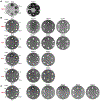Resistance to Enediyne Antitumor Antibiotics by Sequestration
- PMID: 29937405
- PMCID: PMC6208323
- DOI: 10.1016/j.chembiol.2018.05.012
Resistance to Enediyne Antitumor Antibiotics by Sequestration
Abstract
The enediynes, microbial natural products with extraordinary cytotoxicities, have been translated into clinical drugs. Two self-resistance mechanisms are known in the enediyne producers-apoproteins for the nine-membered enediynes and self-sacrifice proteins for the ten-membered enediyne calicheamicin. Here we show that: (1) tnmS1, tnmS2, and tnmS3 encode tiancimycin (TNM) resistance in its producer Streptomyces sp. CB03234, (2) tnmS1, tnmS2, and tnmS3 homologs are found in all anthraquinone-fused enediyne producers, (3) TnmS1, TnmS2, and TnmS3 share a similar β barrel-like structure, bind TNMs with nanomolar KD values, and confer resistance by sequestration, and (4) TnmS1, TnmS2, and TnmS3 homologs are widespread in nature, including in the human microbiome. These findings unveil an unprecedented resistance mechanism for the enediynes. Mechanisms of self-resistance in producers serve as models to predict and combat future drug resistance in clinical settings. Enediyne-based chemotherapies should now consider the fact that the human microbiome harbors genes encoding enediyne resistance.
Keywords: anthraquinone-fused enediyne; antibody-drug conjugate; anticancer drug; biosynthesis; enediyne; resistance; sequence similarity network; sequestration; the human microbiome; tiancimycin.
Copyright © 2018 Elsevier Ltd. All rights reserved.
Conflict of interest statement
DECLARATION OF INTERESTS
B.S. has filed a patent (US, 2018/0009823 A1). The other authors declare no competing interests.
Figures





Similar articles
-
Streptomycin-induced ribosome engineering complemented with fermentation optimization for enhanced production of 10-membered enediynes tiancimycin-A and tiancimycin-D.Biotechnol Bioeng. 2019 Jun;116(6):1304-1314. doi: 10.1002/bit.26944. Epub 2019 Feb 17. Biotechnol Bioeng. 2019. PMID: 30712262
-
Strain Prioritization and Genome Mining for Enediyne Natural Products.mBio. 2016 Dec 20;7(6):e02104-16. doi: 10.1128/mBio.02104-16. mBio. 2016. PMID: 27999165 Free PMC article.
-
Combinatorial metabolic engineering of Streptomyces sp. CB03234-S for the enhanced production of anthraquinone-fused enediyne tiancimycins.Microb Cell Fact. 2024 May 4;23(1):128. doi: 10.1186/s12934-024-02399-w. Microb Cell Fact. 2024. PMID: 38704580 Free PMC article.
-
Biosynthesis of enediyne antitumor antibiotics.Curr Top Med Chem. 2008;8(6):448-59. doi: 10.2174/156802608783955656. Curr Top Med Chem. 2008. PMID: 18397168 Free PMC article. Review.
-
Pharmacology and therapeutic applications of enediyne antitumor antibiotics.Curr Mol Pharmacol. 2008 Jan;1(1):50-60. doi: 10.2174/1874467210801010050. Curr Mol Pharmacol. 2008. PMID: 20021423 Review.
Cited by
-
Newly Discovered Mechanisms of Antibiotic Self-Resistance with Multiple Enzymes Acting at Different Locations and Stages.Antibiotics (Basel). 2022 Dec 26;12(1):35. doi: 10.3390/antibiotics12010035. Antibiotics (Basel). 2022. PMID: 36671236 Free PMC article. Review.
-
Reductive inactivation of the hemiaminal pharmacophore for resistance against tetrahydroisoquinoline antibiotics.Nat Commun. 2021 Dec 6;12(1):7085. doi: 10.1038/s41467-021-27404-3. Nat Commun. 2021. PMID: 34873166 Free PMC article.
-
Challenges and Opportunities to Develop Enediyne Natural Products as Payloads for Antibody-Drug Conjugates.Antib Ther. 2021 Jan;4(1):1-15. doi: 10.1093/abt/tbab001. Epub 2021 Jan 12. Antib Ther. 2021. PMID: 33554043 Free PMC article.
-
Intramolecular C-C Bond Formation Links Anthraquinone and Enediyne Scaffolds in Tiancimycin Biosynthesis.J Am Chem Soc. 2022 Nov 9;144(44):20452-20462. doi: 10.1021/jacs.2c08957. Epub 2022 Oct 24. J Am Chem Soc. 2022. PMID: 36279548 Free PMC article.
-
Discovery and characterization of genes conferring natural resistance to the antituberculosis antibiotic capreomycin.Commun Biol. 2023 Dec 19;6(1):1282. doi: 10.1038/s42003-023-05681-6. Commun Biol. 2023. PMID: 38114770 Free PMC article.
References
-
- Abe S, and Otsuki M (2002). Styrene maleic acid neocarzinostatin treatment for hepatocellular carcinoma. Curr. Med. Chem. Anticancer Agents 2, 715–726. - PubMed
-
- Biggins JB, Onwueme KC, and Thorson JS (2003). Resistance to enediyne antitumor antibiotics by CalC self-sacrifice. Science 301, 1537–1541. - PubMed
-
- Blair JMA, Webber MA, Baylay AJ, Ogbolu DO, and Piddock LJV (2015). Molecular mechanisms of antibiotic resistance. Nat. Rev. Microbiol 13, 42–51. - PubMed
-
- Chen Y, Yu D, Zhang C, Shang B, He H, Chen J, Zhang H, Zhao W, Wang Z, Xu X, et al. (2015). Lidamycin inhibits tumor initiating cells of hepatocellular carcinoma Huh7 through GSK3b/b-catenin pathway. Mol. Carcinog 54, 1–8. - PubMed
Publication types
MeSH terms
Substances
Grants and funding
LinkOut - more resources
Full Text Sources
Other Literature Sources
Molecular Biology Databases

